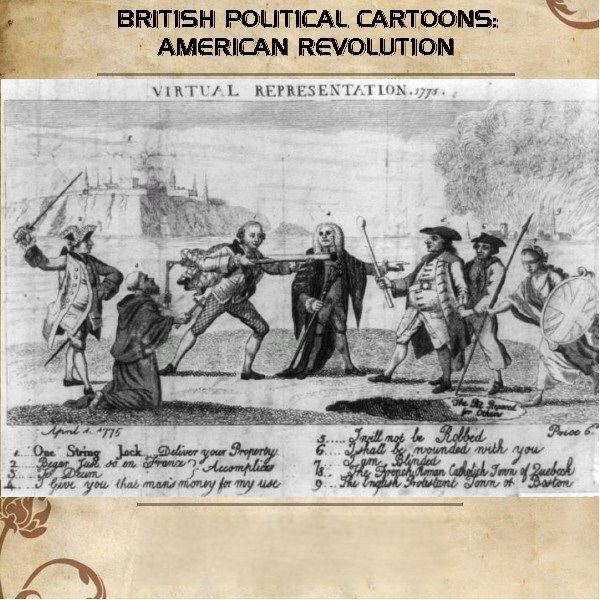
American Revolution: British Political Cartoons
$19.50
Description
A collection of 170 British political cartoons, created between 1766 and 1787, provides visual commentary on the American Revolution.
These drawings illustrate the progression of events, starting with initial resistance in the American colonies, progressing to the full-blown Revolution, and concluding with the consequences of England’s defeat. The collection begins with a cartoon from 1766 marking the repeal of the Stamp Act of 1765 and includes works by prominent British caricaturist James Gillray. The prints offer a satirical representation of British perspectives on the American Revolution. Key events depicted include the Boston Tea Party, the Stamp Act, the Franco-American alliance, the persecution of loyalists, the economic impact of the war and the loss of the American colony, and the practice of tarring and feathering. America is often symbolized through depictions of a rattlesnake, a Native American, a buffalo, or a wild horse. Several of these illustrations were originally published in prominent London periodicals such as London Magazine and The Westminster Magazine.
Prominent figures who are caricatured in these illustrations include George Washington, King George III, Charles Cornwallis, and numerous other significant individuals from both sides of the conflict.
The collection includes notable highlights.
Here are paraphrases of the descriptions you provided:
A political cartoon from March 18, 1766, entitled “The repeal or the funeral of Miss Ame-stamp” depicts a funeral procession occurring along the Thames River. Warehouses are visible in the background, including one identified as a shipping point for goods from Sheffield and Birmingham bound for America. George Grenville is shown carrying a coffin labeled “Miss Ame-stamp, born 1765, died 1766.” Two large bales sit on the dock; one contains returned stamps from America, no longer required due to the Stamp Act’s repeal, and the other holds black cloth shipped from America for the depicted funeral.
A print from May 1, 1774, called “The able doctor; or America swallowing the bitter draught” portrays Lord North, with the “Boston Port Bill” protruding from his pocket, forcibly administering tea (symbolizing the Intolerable Acts) to a partially undressed Native American woman who embodies “America.” Lord Mansfield is depicted holding her arms, while Lord Sandwich, known for his lechery, pins her feet and indecently looks up her skirt. “Britannia” stands behind “America,” averting her gaze and covering her eyes.
A print created October 31, 1774, called “The Bostonian’s paying the excise-man, or tarring & feathering” illustrates five men compelling a tarred and feathered customs official to ingest liquid from a teapot. Lying on the ground next to him is a bucket and a liberty cap. The scene unfolds beneath the “Liberty Tree,” from which a noose is suspended. In the distance, obscured figures are shown dumping tea from a ship.
Here are paraphrased descriptions of the four illustrations:
A political cartoon from January 1, 1775, depicts a meeting in the House of Commons regarding the American colonies. The illustration portrays a group of men, including Lord North, who is shown distributing money, while a map of a burning North America hangs on the wall. Lord Mayor Wilkes is also included, directing attention to North.
A 1775 print shows two men in an outhouse. One man utilizes resolutions from the Continental Congress as toilet paper, implying contempt for the document. The other man is absorbed in reading literature advocating taxation. A depiction of William Pitt after being tarred and feathered hangs on the wall.
An illustration from April 19, 1776, employs a satirical image representing “Bunker Hill” as an elaborate hairstyle. A woman’s profile features an immense coiffure that incorporates depictions of fortifications, military actions, and symbolic flags.
A cartoon dated September 1, 1776, satirically portrays Sullivan’s Island as “Miss Carolina Sulivan,” one of the defiant American daughters. The illustration depicts a woman resembling William Pitt. Her elaborate hairstyle conceals fortifications, cannons, and battle flags, symbolizing the island’s defenses.
Here’s a summary of the political cartoons:
A print from April 1777 depicts Great Britain, personified as an elderly, disabled man, attempting to control rebellious American colonists. The Americans, separated by the Atlantic Ocean, resist British influence through defiance and attack. The image incorporates a quote suggesting England’s weakened state.
An October 10, 1777 cartoon portrays Admiral Richard Howe and General William Howe discussing potential financial gain from the American war. The Devil advises them to prolong the conflict as a means of enrichment.
James Gillray’s May 15, 1780, illustration titled “Argus,” features King George III asleep on his throne. Key figures, including a judge (likely the Earl of Mansfield) and the Earl of Bute, contemplate the future of the crown. A representation of America stands nearby, while a Jacobite expresses his intention to return the crown to Charles Edward the Pretender. The scene also includes a distressed British merchant, a departing Irishman, a slumbering Britannia, and a Dutchman plundering beehives in the background.
Here are paraphrases of the provided descriptions of historical prints:
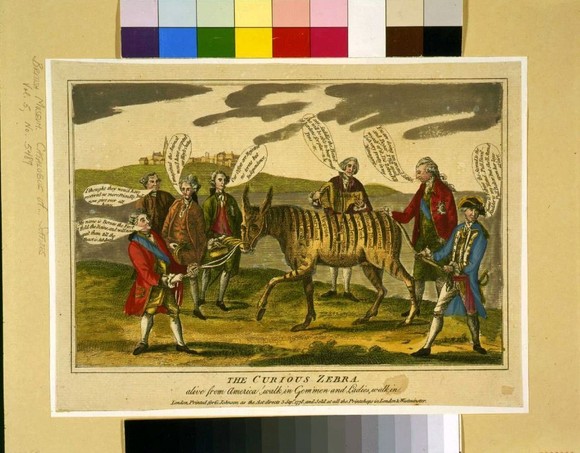
“The belligerent plenipo’s” (December 8, 1782): This cartoon depicts the American colonies, personified as a Native American, rejoicing over gaining a significant portion of the British crown. Meanwhile, France, the Dutch Republic, and Spain, depicted with physical injuries symbolizing their losses, protest their lack of reward for supporting American independence. King George III is positioned on the left side of the image. Ireland, illustrated as an angelic figure, simultaneously petitions for self-governance.
“Peace porridge all hot – the best to be got” (February 11, 1783): This print portrays an Englishman and his servant distributing “peace porridge” to representatives of France, Spain, the Dutch Republic, and America (depicted as a Native woman). The American figure expresses satisfaction with her “dish of Independant Soup.” The print also incorporates lyrics for a song to be sung using the melody of “Roast Beef of Old England.”
“Blessed are the peacemakers” (February 24, 1783): This image shows figures representing Spain and France leading King George III and Lord Shelburne, both tethered by ropes around their necks, toward a gateway constructed of spears. Symbols of British power, specifically a lion, a crown, and a unicorn, are falling from the gateway above. Shelburne is followed by a figure wielding a whip with thirteen lashes representing America, who in turn leads a reluctant Dutchman toward a building labeled “Inquisition” situated atop a hill.
The first visual satire depicts Lord Bute menacing a figure symbolizing colonial America with a firearm. A Parliamentarian directs Bute to seize the American’s wealth for his own gain, prompting the American to reject the act of theft. Britannia, blindfolded, is on the verge of falling into a trap, while a fire engulfs Boston in the distance. A monk with a gallows and cross kneels beside a Frenchman brandishing a sword, with the city of Quebec as the backdrop to their grouping with Bute.
The second cartoon portrays a group attempting to control a zebra, representing the thirteen colonies through names inscribed on its stripes. George Washington is shown holding the zebra’s tail on the right, while Lord North grasps the reins on the left.
Related products
-
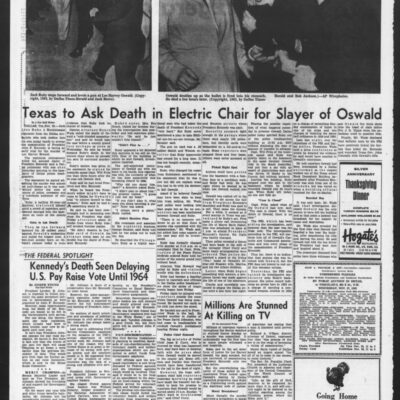
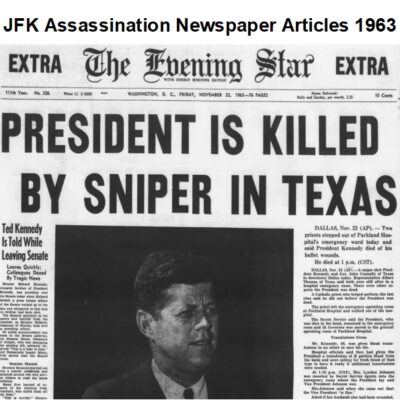
1963 Newspaper Articles on JFK Assassination
$3.94 Add to Cart -
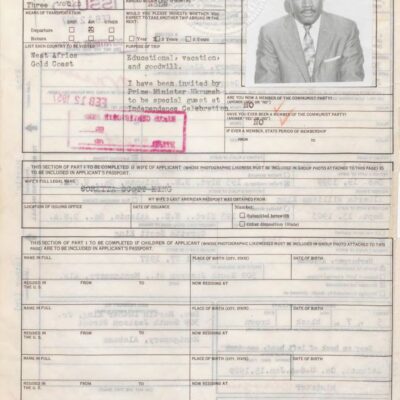
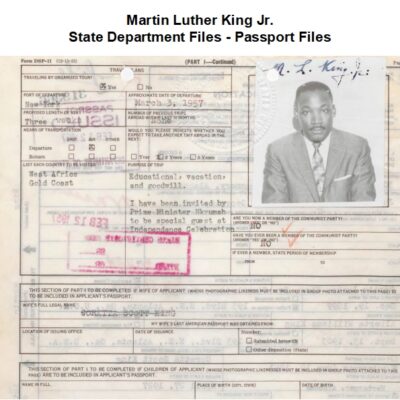
Martin Luther King Jr. State Department Records – Passport Files
$3.94 Add to Cart -

John F. Kennedy Assassination Dallas Police Department Files
$19.50 Add to Cart -

Accidents and Lost Nuclear Weapons Department of Defense Files
$19.50 Add to Cart